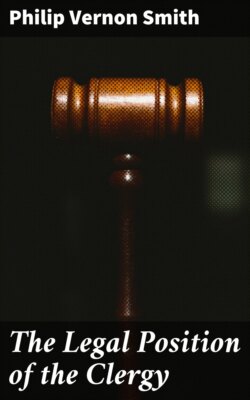Читать книгу The Legal Position of the Clergy - Philip Vernon Smith - Страница 12
На сайте Литреса книга снята с продажи.
Оглавление6. Towards the close of Henry VIII.'s reign the monasteries were dissolved, and their rectories and the rectorial tithes of the parishes and other endowments attached thereto, and the right of nominating vicars or perpetual curates to the parishes passed, with the rest of the monastic property, in some cases into the hands of the Crown or of private individuals who received grants of them from the Crown, while in other cases they went to the endowment of episcopal sees or of colleges, hospitals, or other public institutions. Whichever happened, the rectory and rectorial tithes became thenceforth impropriate, and the vicar or perpetual curate was left with the vicarial tithes and other endowments, or a stipend, as the case might be, to serve the parish as the beneficed parish priest. Later on, and particularly during the nineteenth century, the growth of the population and the rapid increase of our urban centres, owing to the steady migration from the villages to the towns, has rendered the building of new churches and the creation of new ecclesiastical areas a matter of pressing importance; and the same causes have necessitated the employment in the larger parishes of additional clergy, whether stipendiary or voluntary. In some cases an old parish has been divided into distinct and separate parishes, each of which has received a portion of the old church endowments, and has become a rectory, vicarage, or perpetual curacy, according to the status of the old parish;[7] or a vicarage has been converted into a rectory upon a surrender of the rectorial tithes by the impropriator.[8] But, as a rule, new ecclesiastical districts or parishes have been formed and churches built without resorting to the old endowments; and the Church Building and New Parishes Acts provided that the ministers put in charge of these new districts or parishes and churches should be perpetual curates, and should, like the old rectors, vicars, and perpetual curates, be corporations, with perpetual succession.[9] But in 1868 it was enacted that the incumbent of every parish and new ecclesiastical parish, who was authorised to publish banns, and solemnise marriages, churchings, and baptisms in his church, and was not a rector, should, for the purpose of designation only, be styled a vicar, and his benefice should for the same purpose be styled a vicarage.[10] The modern generic title, which includes every beneficed parish priest, is incumbent. The proper and ancient term for rectors, vicars, and all other parochial clergy, whether beneficed or unbeneficed, is curate, as having the cure of souls within the parish.[11] But in modern practice this term, when used by itself, is generally applied to the unbeneficed or assistant curates in a parish.
